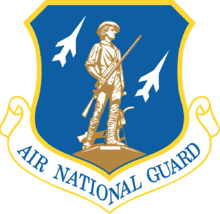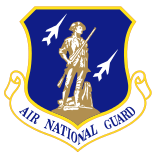O'Hare Air Reserve Station
O'Hare Air Reserve Station  | |
|---|---|
|
Part of Air Force Reserve Command (AFRC) Part of Illinois Air National Guard (IL ANG) | |
| Located at: O'Hare International Airport, Illinois | |
|
56th Fighter Group F-86H Sabers of the 62d FS flying in formation over Detroit, 1951. Serials 53-1262,1264,1288 and 1243 | |
 O'Hare ARS Location of O'Hare Air Reserve Station, Illinois | |
| Coordinates | 41°59′23″N 087°53′35″W / 41.98972°N 87.89306°W |
| Type | Air Reserve Station |
| Site information | |
| Controlled by |
|
| Site history | |
| Built | 1944-1999 |
| In use | 1944-1999 |
| Garrison information | |
| Garrison |
 928th Airlift Wing 928th Airlift Wing 126th Air Refueling Wing 126th Air Refueling Wing 56th Fighter Group 56th Fighter Group |
O'Hare Air Reserve Station is a former United States Air Force base, located at O'Hare International Airport. It was located 15.8 miles (25.4 km) west-northwest of Chicago, Illinois. It was closed in 1999.
History
The original Douglas Aircraft C-54 Skymaster transport manufacturing plant on the northeast side of O'Hare International Airport evolved into a United States Air Force Air National Guard and Air Force Reserve facility after World War II. The Chicago City Council voted to rename the wartime Orchard Field in the Northwest Corner of the city O'Hare Field, in honor of Lieutenant Commander Edward Henry "Butch" O'Hare (March 13, 1914 – November 26, 1943). O'Hare was the United States Navy's first ace in World War II, and Medal of Honor recipient.
Continental Air Command
Beginning in 1947, the airfield was assigned to Continental Air Command (ConAC). The 338th Bombardment Group flew B-29 Superfortresses from the airfield between June 12 and June 27, 1949. The B-29s were replaced by the 437th Troop Carrier Group, flying Curtiss C-46 Commandoes until being activated for the Korean War on March 14, 1951. Its aircraft and personnel were deployed to various units in South Korea and Japan, with the group being inactivated immediately afterwards.[1] In the summer of 1952, the 437th TCW returned to Chicago.
Air Defense Command
During the 1950s, tensions between the United States and the Soviet Union were at a fever pitch; with it came the development of a substantial air defense establishment to counter a potential attack over the North Pole by Soviet bombers. A large network of ground based radars and fighter interceptor units lined the approaches to the United States and Canada.
As a result, the ConAC reserve units were withdrawn and O'Hare was reassigned to Air Defense Command's Central Air Defense Force.[2] The 62d Fighter-Interceptor Squadron was transferred to the station flying F-86 Sabres.[3][4] The 62d FIS remained at O'Hare until October 1, 1959, becoming part of the ADC 56th Fighter Group (Air Defense), and later being upgraded to the F-86D interceptor version of the Sabre.[5] In addition, the federalized Oregon Air National Guard 142d Fighter-Interceptor Wing was stationed at O'Hare from March 1, 1951 to February 6, 1952.
Other Air Defense Command (ADC) squadrons assigned to the 56th Fighter Group at O'Hare Airport were the 42d Fighter-Interceptor Squadron (1953–1955) (F-86D) and the 63d Fighter-Interceptor Squadron (1955–1958) (F-86D/L)[5] In 1960, the need for active duty ADC bases was diminishing and the Air Force inactivated its active-duty ADC units at O'Hare and returned the station back to Continental Air Command (later resesignated Air Force Reserve) to base reserve units under the 2840th Air Reserve Training Wing.[6]
Illinois Air National Guard
In the spring of 1954, the Illinois Air National Guard's 126th Bombardment Group and support units moved to O'Hare from Midway Airport. Also in 1954, the 33rd Infantry Band of the Illinois National Guard was redesignated the 566th Air Force Band and assigned to the group at Midway. This was the first Geographically Separated Unit to be assigned to the group. They often drilled at O'Hare.
In 1961, the unit received the first air refueling mission in the Air National Guard. Hangar 19 was completed just in time to receive the first KC-97L flying tanker in July and the unit was re-designated as the 126th Air Refueling Group, flying the KC-97 Stratotanker. From 1967 to 1976 during Operation Creek Party, some 600 trans-Atlantic flights were flown and 150 million pounds of fuel off-loaded to USAFE and NATO aircraft. It was the first time the Air National Guard had performed a continuous operation without activation.
In 1976, the 126th transitioned to the KC-135 Stratotanker, was redesignated as the 126th Air Refueling Wing (126 ARW) and was placed under the operational command of the Strategic Air Command (SAC). Following the inactivation of SAC in 1992, the 126 ARW came under the command of the newly established Air Mobility Command (AMC).
The unit began performing a Distinguished Visitor mission in June 1997, when the 928th Airlift Wing was disbanded (the host Air Force Reserve unit at O'Hare). This mission called for support of the President of the United States and Air Force One, as well as the aircraft of visiting heads of state, when landing at O'Hare. The Distinguished Visitor list included the Chancellor of Germany, the President of Mexico, the Prime Minister of Italy, the President of Romania, the Prime Minister of Japan, the Prime Minister of Great Britain and the Premier of China.
Air Force Reserve
In 1960, the bomber threat to the United States was being eclipsed by concern over Soviet ballistic missiles, and the need for active duty air defense bases was diminishing. The Air Force inactivated its active-duty air defense units at O'Hare and returned the station to the Air Force Reserve to base reserve units under the 2840th Air Reserve Training Wing. O'Hare Air Reserve Station was also long-time home to the 928th Tactical Airlift Wing, later the 928th Airlift Wing (928 AW), of the Air Force Reserve, flying the C-130 Hercules.
The 928th was operationally gained by the Tactical Air Command (TAC) until 1975, the Military Airlift Command (MAC) until 1992, and following the inactivation of SAC, TAC and MAC, by the newly established Air Mobility Command (AMC) from 1992 forward.[7] Among many operations supported during the C-130's time in Chicago include Operation PROVIDE PROMISE, supporting the long-lasting operations in the Balkans during the early and mid-1990s.
Closure
The 1993 Base Realignment and Closure Commission recommended the closure of O'Hare Air Reserve Station as proposed by the municipal government of the City of Chicago and the transfer of both the 126 ARW and 928 AW to new facilities to be constructed at Scott AFB, Illinois, with much of the associated costs to be borne by the City of Chicago. The 1995 BRAC Commission modified the closure of O'Hare Air Reserve Station as recommended by the 1993 BRAC by inactivating the 928th Airlift Wing, rather than relocating the unit, and distributing its C-130 aircraft to Air Force Reserve C-130 units at Dobbins ARB, Georgia and Peterson AFB, Colorado.[7]
The 126 ARW moved from the former O'Hare Air Reserve Station at O'Hare International Airport to Scott AFB, Illinois as recommended by the Base Realignment and Closure Commission's Report to Congress in conjunction with the closure of the Air Force Reserve Command and Air National Guard facilities at O'Hare.
The Chicago Air Guard (the 126 ARW, 217 EIS, 264 CBCS, and 566 AF Band) held its final Retirement Ceremony with 1500 members in attendance on 16 June 1999 and the keynote speaker being the President of the United States. Later in the month, a grand ball was held with over 800 current and former members attending. Finally, the United States flag flying over O'Hare Air Reserve Station was officially lowered before 500 members and their families, and the last KC-135E departed for Scott AFB, Ill., on the 28th of July 1999. The Chicago Air Guard ceased to exist on that day.
Following the closure of the O'Hare Air Reserve Station, the former USAF facilities were redeveloped for air cargo and general aviation. Today, Signature Flight Support services private aircraft in this area. The large parking ramp for the tankers and transports remains at the airport. Most of the former military facilities, including the hangars and the support buildings have been torn down, their foundations remaining visible in aerial imagery.
See also
References
![]() This article incorporates public domain material from the Air Force Historical Research Agency website http://www.afhra.af.mil/.
This article incorporates public domain material from the Air Force Historical Research Agency website http://www.afhra.af.mil/.
- ↑ Maurer Maurer, Air Force Combat Units Of World War II, Office of Air Force History, 1983
- ↑ USAFHRA Document 00451100
- ↑ USAFHRA Document 00441742
- ↑ USAFHRA Organizational Records page, 62d Fighter Squadron
- 1 2 USAF Aerospace Defense Command publication, The Interceptor, January 1979 (Volume 21, Number 1).
- ↑ USAFHRA Document 00462865
- 1 2 O'Hare IAP Air Reserve Station
- A Handbook of Aerospace Defense Organization 1946 - 1980, by Lloyd H. Cornett and Mildred W. Johnson, Office of History, Aerospace Defense Center, Peterson Air Force Base, Colorado
- Maurer, Maurer (1983). Air Force Combat Units Of World War II. Maxwell AFB, Alabama: Office of Air Force History. ISBN 0-89201-092-4.
- Ravenstein, Charles A. (1984). Air Force Combat Wings Lineage and Honors Histories 1947-1977. Maxwell AFB, Alabama: Office of Air Force History. ISBN 0-912799-12-9.
- Aerospace Defense Command publication, The Interceptor, January 1979 (Volume 21, Number 1).



